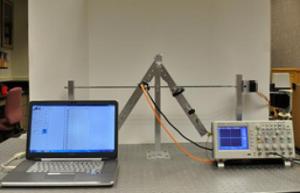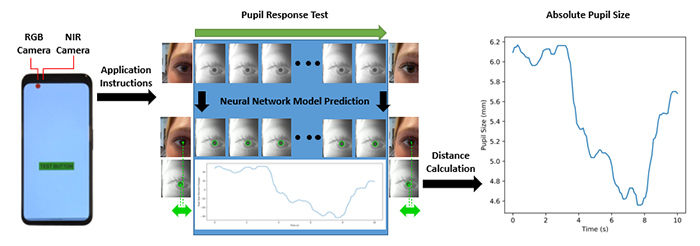
A twist on thin-film technology may provide a way to optically detect and analyze multiple substances simultaneously, leading to quicker diagnostics in such industries as health care and homeland security, according to Penn State researchers.
One current optical-sensing technology can launch and guide a single light wave, called a surface-plasmon-polariton wave — SPP wave — that travels along the flat interface of the sample to be analyzed and a metal film. The SPP wave is launched by sending a light beam through a prism to the other face of the metal film. A photon detector eventually collects the beam that was reflected back into the prism. Any change in the optical properties of the sample critically alters the reflected beam.
The detector records this alteration, which analysts can then use as an optical fingerprint to help them identify the changes in the chemical composition of the sample, according to Akhlesh Lakhtakia, Charles Godfrey Binder Professor of Engineering Science and Mechanics.
However, because the technology allows for only one SPP wave of a certain frequency to be guided through the device, the properties of only one substance can be analyzed for each sensor, said Lakhtakia, who worked with Stephen Swiontek and Drew Pulsifer, both doctoral students in engineering science and mechanics.
“This is a very effective technology and it’s being used in many industries, such as pharmaceuticals, agriculture and forensics, for example,” said Lakhtakia. “But allowing only one SPP wave per sensor is a disadvantage.”
The researchers designed a thin film that can create additional channels for the SPP waves. This thin film, which is attached to the metal surface, is porous and can be infiltrated by fluids that can later be analyzed.
Conventional thin films are made by layering clumps of atoms in rows on a surface, or substrate. To make more channels for the SPP waves, Pulsifer and Swiontek slowly rotated the substrate during the fabrication of the thin film, sculpturing it to create nanoscale springs, so that the regions between the springs can be infiltrated. Lakhtakia and his students had showed earlier that the interface of this type of thin film and a metal film can guide many SPP waves at a fixed frequency.
To test the new optical sensing technique, the researchers built a prototype of an optical-sensing device that has two legs. On one leg, a laser focuses a beam of light toward a prism that rests at the apex of the device. The peak of the prism points down, so that the researchers can add the metal film and sculptured thin film to the flat surface on the prism’s hypotenuse.
The light beam is then refracted toward a photon detector on the opposite leg of the device.
The researchers, who report their findings today (March 11) in Scientific Reports, recorded multiple SPP waves through a sample containing water, one containing water and sucrose and a control sample.
Lakhtakia said the team performed a series of sensitivity tests on the system and found that the method was nearly as reliable and as accurate as state-of-the-art technology in detecting and analyzing substances.
“It gives us hope that we will have a nice system to work with and that we can even increase reliability and accuracy,” said Lakhtakia.
The system could be optimized by experimenting with different substrate materials and by adding extra photon detectors and optical filters, according to the researchers.
“This is a billion-dollar industry,” said Swiontek.”If we can detect more than one analyte reliably and we can optimize the process, I think there’s a possibility that it can replace the traditional method.”
The Latest Bing News on:
Diagnostics
- CODX Stock Earnings: Co-Diagnostics Misses EPS, Misses Revenue for Q1 2024on May 9, 2024 at 9:58 pm
Co-Diagnostics (NASDAQ:CODX) just reported results for the first quarter of 2024.Co-Diagnostics reported earnings per share of -31 cents. This was below the analyst estimate for EPS of -21 cents.The ...
- Lung disease diagnostics firm Biodesix improved results in Q1on May 9, 2024 at 1:49 pm
Biodesix Inc., which specializes in tools to detect lung disease, boosted its year-over-year performance in the first quarter of 2024.
- Accelerate Diagnostics, Inc. (NASDAQ:AXDX) Q1 2024 Earnings Call Transcripton May 9, 2024 at 9:28 am
Q1 2024 Earnings Call Transcript May 8, 2024 Accelerate Diagnostics, Inc. isn’t one of the 30 most popular stocks among hedge funds at the end of the third quarter (see the details here). Operator: ...
- Accelerate Diagnostics Reports Q1 Loss, Misses Revenue Estimateson May 9, 2024 at 7:12 am
Accelerate Diagnostics (NASDAQ:AXDX) came out with a quarterly loss of $0.88 per share versus the Zacks Consensus Estimate of a loss of $0.72. This compares to loss of $1.70 per share a year ago.
- Northwell opens $3.2M molecular diagnostics laboratoryon May 9, 2024 at 7:05 am
The 2,800-square-foot facility is designed to identify targeted cancer therapies. Northwell said that the lab will enhance the ability to accurately diagnose and provide a prognosis for cancer ...
- Global DNA Diagnostics Market Poised for Remarkable Growth, Projected to Reach USD 51.5 Billion by 2032on May 8, 2024 at 9:45 pm
The global DNA diagnostics market has witnessed substantial growth in recent years, with a notable surge in 2021, reaching a valuation of US$ 20.9 Billion. According to market projections, this growth ...
- Global HIV Diagnostics Market Poised for Remarkable Growth targeting USD 6.4 Billion by 2032 at a CAGR of 7.9%: Future Market Insights Reporton May 8, 2024 at 8:28 pm
The global HIV diagnostics market is set to experience a significant surge, as projected by the latest report from Future Market Insights. With anticipated growth from USD 3.0 billion in 2022 to an ...
- Accelerate Diagnostics: Q1 Earnings Snapshoton May 8, 2024 at 2:23 pm
TUCSON, Ariz. (AP) — TUCSON, Ariz. (AP) — Accelerate Diagnostics Inc. (AXDX) on Wednesday reported a loss of $17 million in its first quarter. The Tucson, Arizona-based company said it had a loss of ...
- Accelerate Diagnostics earnings preview: what to expecton May 7, 2024 at 6:06 am
On May 8, Accelerate Diagnostics is reporting earnings from Q1. In terms of EPS, 2 analysts are predicting losses of $0.544 per share as opposed to losses of $1.710 per share in the same quarter of ...
- Quest plans to purchase PathAI’s diagnostic lab as part of AI ramp-upon May 6, 2024 at 9:18 am
AI and digital technologies have tremendous potential to improve cancer care, and Quest has the know-how to scale and deliver innovations that are high quality, efficient and broadly accessible," said ...
The Latest Google Headlines on:
Diagnostics
[google_news title=”” keyword=”diagnostics” num_posts=”10″ blurb_length=”0″ show_thumb=”left”] [/vc_column_text]The Latest Bing News on:
Efficient diagnostics
- Diagnostic Imaging for Women Enhances Mammography Quality with AI: Results Presented at ASMIRT 2024on May 9, 2024 at 6:05 pm
At the Australian Society of Medical Imaging and Radiation Therapy (ASMIRT) conference this week in Darwin, Diagnostic Imaging for Women (difw), together with Volpara Health announced significant ...
- TOPDON USA’s New Phoenix Lite 3 Diagnostic Scanner Adds Topology, CAN-FD Protocol and Optional ADAS Calibration Software Functionalityon May 9, 2024 at 3:44 am
Assessment of component integrity and functionality to facilitate rapid identification of fault causes for faster and more efficient repairs. Wireless diagnostics via VCI empowers for flexible ...
- AI in Medical Diagnostics Market Report: Comprehensive Industry Size and Share Review for 2032.on May 8, 2024 at 11:21 pm
The global AI in medical diagnostics market size was US$ 0.69 billion in 2021. The global AI in medical diagnostics market is forecast to grow to US$ 17.9 billion by 2030 by registering a compound ...
- Global DNA Diagnostics Market Poised for Remarkable Growth, Projected to Reach USD 51.5 Billion by 2032on May 8, 2024 at 9:45 pm
The global DNA diagnostics market has witnessed substantial growth in recent years, with a notable surge in 2021, reaching a valuation of US$ 20.9 Billion. According to market projections, this growth ...
- Automotive Remote Diagnostics Market to reach USD 108.2 Billion by 2034on May 7, 2024 at 11:08 pm
The automotive remote diagnostics market is experiencing remarkable growth, projected to reach a staggering USD 108.2 billion by 2034, fueled by a CAGR of 17.4%. This surge is driven by the rise of ...
- Quest Diagnostics (DGX) Grows in Digital Pathology With New Dealon May 7, 2024 at 8:23 am
Quest Diagnostics' (DGX) pathology laboratories nationwide are set to get a boost with PathAI's AISight digital pathology image management system.
- Med-Gemini beats GPT-4, achieves 91.1% accuracy in medical diagnosticson May 7, 2024 at 7:38 am
They could process information from text, images, video and audio. This makes Med-Gemini far more efficient as it’s fine-tuned with all these specialties. Some of these include: Med-Gemini is capable ...
- Quest plans to purchase PathAI’s diagnostic lab as part of AI ramp-upon May 6, 2024 at 9:18 am
AI and digital technologies have tremendous potential to improve cancer care, and Quest has the know-how to scale and deliver innovations that are high quality, efficient and broadly accessible," said ...
- Quest Finds its Path to AI in Cancer Diagnostics Through M&Aon May 1, 2024 at 10:25 am
Quest Diagnostics has found its path to artificial intelligence in cancer diagnosis through M&A. The Secaucus NJ-based company said it was acquiring select assets of PathAI Diagnostics, the business ...
- Quest Diagnostics carves out PathAI's digital pathology lab, plots AI ramp-upon May 1, 2024 at 7:30 am
Quest Diagnostics is building out its artificial intelligence-powered cancer pathology offerings through a multi-layered deal with PathAI—acquiring some assets, licensing out others. | Quest ...
The Latest Google Headlines on:
Efficient diagnostics
[google_news title=”” keyword=”efficient diagnostics” num_posts=”10″ blurb_length=”0″ show_thumb=”left”]
The Latest from the BLOGOSPHERE










